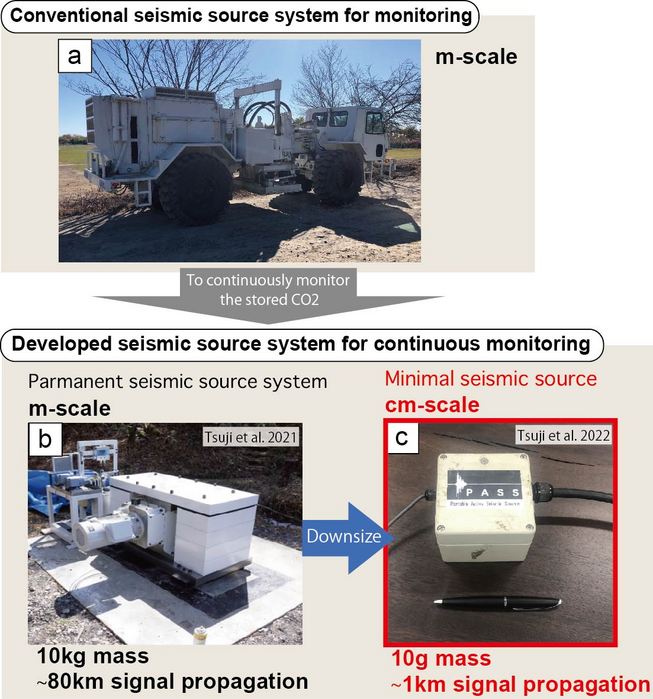Reviewed by Mila PereraSep 19 2022
A promising approach to combat climate change is underground carbon sequestration; however, numerous obstacles must be addressed before this technology can be used on a large scale.

(a) Seismic source system commonly used for imaging and monitoring of subsurface reservoirs. (b) Meter-scale continuous monitoring source system. (c) Centimeter-scale continuous monitoring source system developed in this study. Image Credit: Takeshi Tsuji
By discovering how to continuously and inexpensively monitor carbon reservoirs to find leaks or other changes that need care, a new study from Japan may be able to overcome one of these challenges.
Seismic waves, produced by earthquakes or man-made sources, can be used to monitor underground features like carbon reserves. However, continuous monitoring of carbon reservoir sizes is prohibitively expensive and practically difficult because seismic monitoring often requires huge, expensive apparatus.
An ultra-compact, centimeter-scale seismic source has been created by a research team from the Graduate School of Engineering at the University of Tokyo and the International Institute for Carbon-Neutral Energy Research at Kyushu University to help solve this issue by enabling continual assessment of carbon reservoirs.
The Portable Active Seismic Source (PASS) was initially intended for extraterrestrial applications, including geophysical studies on the Moon and Mars. The PASS could also be used for numerous Earth-based applications.
Because of the device’s small size, the vibrations it produces are relatively weak, but when these vibrations are produced continuously, the resulting signals can be stacked together, allowing transmission over long distances. With a four-centimeter motor, the signal could be transmitted one kilometer—the scale needed for monitoring strata used to store carbon dioxide.
Takeshi Tsuji, Study Lead Author, Professor and Principal Investigator, University of Tokyo
Compared to traditional seismic sources, which are often several meters in size, the PASS is far cheaper to deploy and operate due to its compact size. The tiny device can even be launched by drone in remote locations and run on a 12 V vehicle battery.
The PASS was tested at two field locations: the embankment of tailing in a mining region and a riverside.
The PASS system has great potential for a wide variety of scientific and engineering applications, including monitoring for potential disasters such as landslides and volcanoes, and imaging man-made structures such as tunnels, dams, and embankments.
Takeshi Tsuji, Study Lead Author, Professor and Principal Investigator, University of Tokyo
The implementation of carbon sequestration projects can benefit significantly from the affordability and applicability of continuous subsurface monitoring utilizing this newly developed PASS technology, which enables the detection of abrupt changes in reservoirs that might contribute to CO2 leakage.
Improved safety may result in these projects gaining popularity, along with other geoengineering efforts.
Journal Reference
Tsuji, T., et al. (2022) 4 cm Portable Active Seismic Source (PASS) for Meter‐ to Kilometer‐Scale Imaging and Monitoring of Subsurface Structures. Seismological Research Letters. doi.org/10.1785/0220220049.